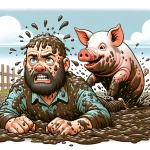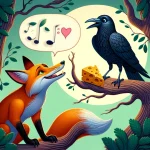
The tale features a dog, a cheerful but slightly greedy pup, who finds a delicious bone on his journey home.
As he crosses a shimmering stream, the dog spots another dog in the water, seemingly with a larger bone.


Overcome by greed, he barks to scare the other dog away, but alas!
His own bone falls into the stream and is swept away, leaving the dog to ponder his actions.


“The Dog and His Reflection,”
Once upon a sunny day, Teddy, a cheerful pup, was trotting home, his tail wagging with joy. In his mouth, he carried a scrumptious bone, a gift from the kind-hearted Mr. Butcher.
As Teddy pranced over a narrow, wooden bridge, he paused to admire the sparkling river below. To his surprise, he spotted another dog in the water! This dog had a bone too, but oh, it seemed so much larger and yummier than his own!
Teddy, with eyes wide in wonder, forgot all about thinking wisely. He imagined how grand it would be to have that enormous bone. So, with a little “woof” of excitement, he dropped his own bone and leaped towards the water, eager to snatch the bigger prize.
Splash! Into the river went Teddy, but instead of a bone, he found himself swimming for safety. The other dog and the bigger bone had vanished like a bubble!
After a splashy struggle, Teddy finally reached the shore. Dripping wet and without his tasty bone, he sat down, a frown wrinkling his furry face. As he shook off the water droplets, he realized, with a little whimper of regret, that the other dog was just his own reflection.
“Oh, Teddy,” he sighed to himself, “you silly pup! You had a fine bone and lost it chasing shadows.”
And from that day on, whenever Teddy crossed the bridge with a bone, he never looked down into the water again, but trotted on, grateful for what he had.
A Canine’s Conundrum: Delving into Aesop’s ‘The Dog and His Reflection’
The beauty of Aesop’s fables lies in their simplicity and the ease with which they communicate complex human emotions and moral dilemmas. In this tale, the dog embodies the human tendency towards greed, while the river and its reflection symbolize the illusions that often lead us astray. The dog’s misguided action of dropping his meat in the pursuit of a larger piece serves as a stark reminder of the dangers of letting greed cloud our judgment.
At the heart of this fable is the dog’s inability to distinguish between reality and illusion, a common human failing. The dog, in his greed, cannot see that the meat he covets is merely a reflection of his own. This inability to discern the truth from illusion leads him to make a decision that ultimately leaves him with nothing.
This fable is not just a tale about a dog and his reflection, but a mirror held up to human nature. It underscores the need for us to be content with what we have and not fall prey to the illusions of grandeur that often lead us to lose everything we hold dear.
Reflections and Revelations: A Cheerful Look at Aesop’s Canine Fable
Aesop’s fables have a way of making us chuckle at the end, not just because of the amusing situations the characters often find themselves in, but also because of the profound truths they reveal. “The Dog and His Reflection” is no exception. Despite the dog’s misfortune, there’s a certain cheerfulness in the way the story unfolds and the lesson it imparts.
The dog’s predicament, while unfortunate, is also a source of humor. After all, who hasn’t made a fool of themselves in the pursuit of something they desire? The dog’s naivety and greed, while leading to his downfall, also make him relatable and endearing. It’s a gentle reminder that we’re all susceptible to the same mistakes, making the fable a delightful blend of humor and wisdom.
The cheerfulness of this fable is further enhanced by its universal appeal. Regardless of age, culture, or background, everyone can relate to the dog’s situation and learn from his mistake. The story serves as a light-hearted yet powerful reminder of the pitfalls of greed and the importance of contentment.
Finally, the fable’s cheerfulness is rooted in its simplicity. The tale doesn’t rely on complex plot twists or intricate character development. Instead, it uses a simple narrative and relatable characters to convey a timeless lesson. This simplicity adds to the charm of the fable, making it a delightful read for all ages.
In conclusion, “The Dog and His Reflection” is a charming tale that combines humor, wisdom, and simplicity to deliver a timeless message. It serves as a gentle reminder of the dangers of greed and the importance of contentment. Despite its age, this fable continues to resonate with readers, proving that Aesop’s wisdom is truly timeless. Whether you’re a child hearing it for the first time or an adult revisiting it, this delightful fable is sure to leave you with a smile on your face and a valuable lesson in your heart.



